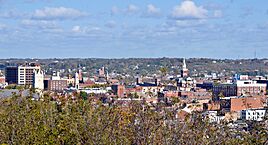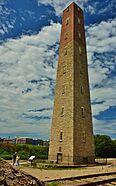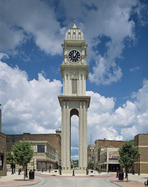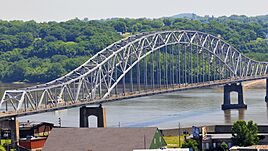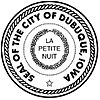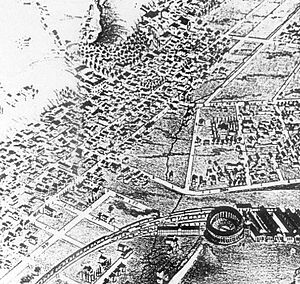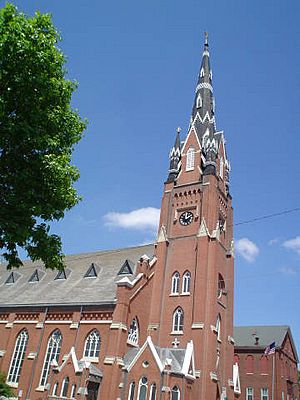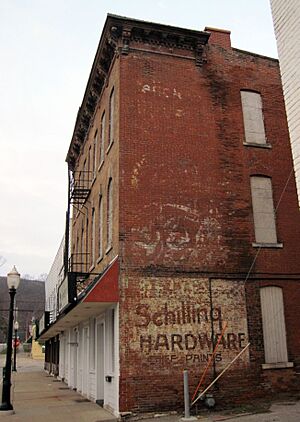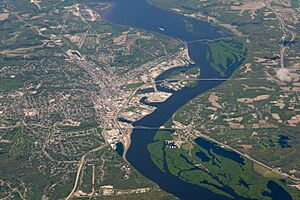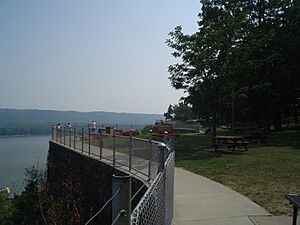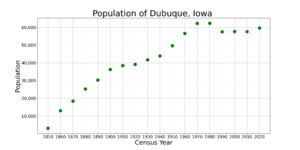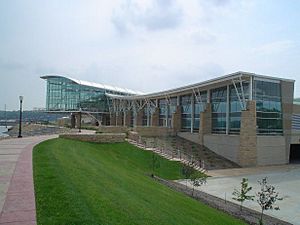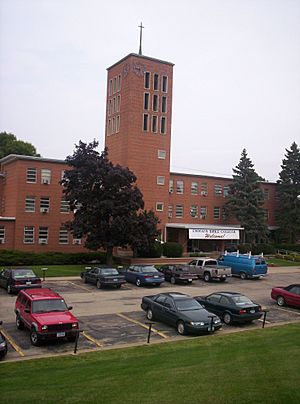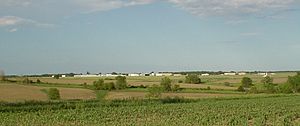Dubuque, Iowa facts for kids
Dubuque (pronounced "dəb-YOOK") is a city in Iowa, United States, located right along the Mississippi River. It's the main city in Dubuque County. In 2020, about 59,667 people lived there. Dubuque is special because it sits where Iowa, Illinois, and Wisconsin meet, a place often called the Tri-State Area. It's a key spot for business, industry, education, and culture in this region. Geographically, it's part of the Driftless Area, which is a unique part of North America that wasn't flattened by glaciers long ago.
Dubuque is a popular place for tourists. People visit to see its interesting buildings, enjoy the casinos, and explore the riverside. The city is also home to five colleges and universities. While Dubuque used to be mostly about manufacturing, its economy now includes healthcare, publishing, and financial services.
Quick facts for kids
Dubuque, Iowa
|
|||||
|---|---|---|---|---|---|
|
Downtown Dubuque
|
|||||
|
|||||
| Nicknames:
"The Key City", "City of Five Flags", "Masterpiece on the Mississippi"
|
|||||
| Motto(s):
"Showing the Spirit"
|
|||||
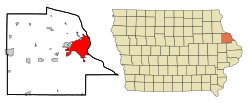
Location in the state of Iowa
|
|||||
| Country | |||||
| State | |||||
| County | Dubuque | ||||
| Founded | 1833 | ||||
| Incorporated | January 28, 1857 | ||||
| Founded by | Julien Dubuque | ||||
| Government | |||||
| • Type | Council-Manager | ||||
| Area | |||||
| • City | 32.01 sq mi (82.90 km2) | ||||
| • Land | 30.92 sq mi (80.09 km2) | ||||
| • Water | 1.08 sq mi (2.81 km2) | ||||
| Elevation | 617 ft (188 m) | ||||
| Population
(2020)
|
|||||
| • City | 59,667 | ||||
| • Rank | 11th in Iowa | ||||
| • Density | 1,929.60/sq mi (745.03/km2) | ||||
| • Metro | 96,370 | ||||
| Time zone | UTC−6 (CST) | ||||
| • Summer (DST) | UTC−5 (CDT) | ||||
| ZIP codes |
52001–52004, 52099
|
||||
| Area code(s) | 563 | ||||
| FIPS code | 19-22395 | ||||
| GNIS feature ID | 0456040 | ||||
| Website | www.cityofdubuque.org | ||||
Contents
History of Dubuque
The first European to settle in what is now Dubuque was a French-Canadian pioneer named Julien Dubuque. He arrived in 1785. In 1788, he got permission from the Spanish government and the local Meskwaki people to mine the area's rich lead deposits.
Control of the land changed hands a few times. It went from Spain to France, and then to the United States in 1803 as part of the Louisiana Purchase. The Meskwaki people continued to mine with U.S. government support until 1830.
The city of Dubuque was officially started in 1833 and was named after Julien Dubuque. It became part of the new state of Iowa in 1846. After the lead mines ran out, Dubuque became a center for other industries. It was important for the timber industry because of nearby forests. Later, boat building, brewing, and the railroad industry became very important.
Between 1860 and 1880, Dubuque was one of the 100 largest cities in the United States. Iowa's first church was built by Methodists in 1833.
In the mid-1800s and early 1900s, many poor German and Irish Catholic immigrants came to Dubuque. They came to work in the city's factories. Because of so many Catholic families, Dubuque became the main center for the Catholic Church in the area. Many religious buildings like convents and abbeys were built.
In the 1980s, Dubuque's economy faced challenges as manufacturing changed. But in the 1990s, the city's economy grew and became more diverse. Now, tourism, technology, and publishing are some of the biggest and fastest-growing businesses. Dubuque attracts over 2 million tourists every year. The city has worked to develop tourist spots like the America's River Project in the Port of Dubuque.
Geography of Dubuque
Dubuque is located at 42°30′16″N 90°41′13″W / 42.50444°N 90.68694°W. The city covers about 31.22 square miles (80.86 km²). Most of this area is land, with some water from the Mississippi River.
Downtown Dubuque
Downtown Dubuque is the city's main business area. It has many government buildings and cultural places. This area is the center for transportation and shopping in Dubuque. It includes neighborhoods like Cable Car Square, the Central Business District, and the Millwork District. The Port of Dubuque is also downtown, with attractions like the Grand Harbor Resort and Waterpark. Important historic buildings like the Shot Tower and St. Raphael's Cathedral are found here.
North End
Dubuque's North End was first settled in the late 1800s by German immigrants who worked in factories. This area still has many of Dubuque's largest factories. It includes places like Eagle Point Park and Linwood Cemetery.
South End
The South End was traditionally the neighborhood for Irish American immigrants and was known as Little Dublin. You can still find Irish pubs and stores there. The area also has important Irish Catholic churches like St. Columbkille's and St. Patrick's. The South End now covers a larger area and has many older, well-established neighborhoods. It includes places like the Mines of Spain State Recreation Area.
West End
Dubuque's West End is a large, mostly suburban area that grew after World War II. Many new homes and shopping centers were built here, including Kennedy Mall. This area continues to grow quickly with new neighborhoods and shopping areas. It has many schools, industrial parks, and large shopping centers.
Climate
Dubuque has four distinct seasons. Spring is usually wet and rainy. Summers are sunny and warm. Autumn is mild, and winters are typically cloudy and snowy.
| Climate data for Dubuque Regional Airport, 1991–2020 normals, extremes 1873–present | |||||||||||||
|---|---|---|---|---|---|---|---|---|---|---|---|---|---|
| Month | Jan | Feb | Mar | Apr | May | Jun | Jul | Aug | Sep | Oct | Nov | Dec | Year |
| Record high °F (°C) | 63 (17) |
71 (22) |
86 (30) |
93 (34) |
104 (40) |
104 (40) |
110 (43) |
107 (42) |
99 (37) |
90 (32) |
78 (26) |
69 (21) |
110 (43) |
| Mean maximum °F (°C) | 46.0 (7.8) |
50.6 (10.3) |
67.6 (19.8) |
78.8 (26.0) |
85.4 (29.7) |
90.1 (32.3) |
91.0 (32.8) |
89.4 (31.9) |
87.2 (30.7) |
80.2 (26.8) |
64.5 (18.1) |
50.7 (10.4) |
92.5 (33.6) |
| Mean daily maximum °F (°C) | 26.5 (−3.1) |
30.9 (−0.6) |
44.1 (6.7) |
57.7 (14.3) |
69.2 (20.7) |
78.5 (25.8) |
81.5 (27.5) |
79.6 (26.4) |
72.9 (22.7) |
59.9 (15.5) |
44.8 (7.1) |
31.8 (−0.1) |
56.4 (13.6) |
| Daily mean °F (°C) | 18.8 (−7.3) |
22.9 (−5.1) |
35.2 (1.8) |
47.4 (8.6) |
58.8 (14.9) |
68.5 (20.3) |
71.7 (22.1) |
69.8 (21.0) |
62.3 (16.8) |
49.9 (9.9) |
36.4 (2.4) |
24.5 (−4.2) |
47.2 (8.4) |
| Mean daily minimum °F (°C) | 11.1 (−11.6) |
15.0 (−9.4) |
26.3 (−3.2) |
37.2 (2.9) |
48.5 (9.2) |
58.6 (14.8) |
62.0 (16.7) |
60.0 (15.6) |
51.8 (11.0) |
39.9 (4.4) |
28.1 (−2.2) |
17.2 (−8.2) |
38.0 (3.3) |
| Mean minimum °F (°C) | −12.7 (−24.8) |
−6.0 (−21.1) |
5.5 (−14.7) |
22.4 (−5.3) |
33.4 (0.8) |
45.7 (7.6) |
51.7 (10.9) |
50.0 (10.0) |
37.0 (2.8) |
23.5 (−4.7) |
10.7 (−11.8) |
−4.5 (−20.3) |
−17.0 (−27.2) |
| Record low °F (°C) | −32 (−36) |
−31 (−35) |
−20 (−29) |
10 (−12) |
21 (−6) |
36 (2) |
40 (4) |
40 (4) |
24 (−4) |
10 (−12) |
−17 (−27) |
−25 (−32) |
−32 (−36) |
| Average precipitation inches (mm) | 1.32 (34) |
1.57 (40) |
2.25 (57) |
4.06 (103) |
4.30 (109) |
5.19 (132) |
4.80 (122) |
3.95 (100) |
3.82 (97) |
2.93 (74) |
2.21 (56) |
1.80 (46) |
38.20 (970) |
| Average snowfall inches (cm) | 10.7 (27) |
10.6 (27) |
5.7 (14) |
1.9 (4.8) |
0.0 (0.0) |
0.0 (0.0) |
0.0 (0.0) |
0.0 (0.0) |
0.0 (0.0) |
0.5 (1.3) |
2.8 (7.1) |
10.3 (26) |
42.5 (108) |
| Average precipitation days (≥ 0.01 in) | 9.1 | 8.9 | 10.1 | 11.4 | 13.0 | 12.2 | 9.7 | 9.0 | 8.7 | 8.9 | 8.3 | 9.1 | 118.4 |
| Average snowy days (≥ 0.1 in) | 7.8 | 6.9 | 4.2 | 1.3 | 0.0 | 0.0 | 0.0 | 0.0 | 0.0 | 0.5 | 2.4 | 6.3 | 29.4 |
| Source: NOAA | |||||||||||||
Population of Dubuque
| Historical population | ||
|---|---|---|
| Year | Pop. | ±% |
| 1850 | 3,108 | — |
| 1860 | 13,000 | +318.3% |
| 1870 | 18,434 | +41.8% |
| 1880 | 25,254 | +37.0% |
| 1890 | 30,311 | +20.0% |
| 1900 | 36,297 | +19.7% |
| 1910 | 38,494 | +6.1% |
| 1920 | 39,141 | +1.7% |
| 1930 | 41,679 | +6.5% |
| 1940 | 43,892 | +5.3% |
| 1950 | 49,671 | +13.2% |
| 1960 | 56,606 | +14.0% |
| 1970 | 62,309 | +10.1% |
| 1980 | 62,374 | +0.1% |
| 1990 | 57,538 | −7.8% |
| 2000 | 57,686 | +0.3% |
| 2010 | 57,637 | −0.1% |
| 2020 | 59,667 | +3.5% |
| Source: Source: U.S. Decennial Census |
||
In 2020, Dubuque had a population of 59,667 people. Most residents (85.1%) were White. About 6.3% were Black or African American, and 3.7% were Hispanic or Latino.
Dubuque Metropolitan Area
Dubuque is the main city in the Dubuque Metropolitan Statistical Area (MSA). This area includes all of Dubuque County. In 2010, the population of Dubuque County was 93,653.
Religion in Dubuque
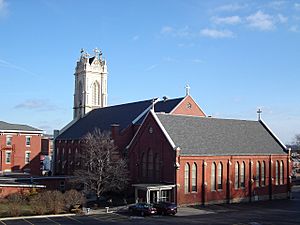
Dubuque has a strong religious history. The first Christian church in Iowa, St. Raphael's Cathedral, was built here in 1833 by Catholic settlers. The city was important for the growth of the Catholic Church in the Western United States. Many important Catholic leaders have lived in Dubuque.
In 2010, about 53% of Dubuque County residents who regularly attended services were Catholic. This is much higher than the rest of Iowa. The city has 52 different churches, including 11 Catholic churches, 40 Protestant churches, 1 Orthodox church, 1 Jewish synagogue, and 1 mosque. Dubuque is also home to three theological seminaries, which are schools that train religious leaders.
Economy of Dubuque
For many years, Dubuque's economy relied on manufacturing companies like Deere and Company and Flexsteel Industries. While manufacturing is still important, the economy has become much more diverse. Now, healthcare, education, tourism, publishing, and financial services are also big parts of the city's economy.
Some of Dubuque's largest employers include:
- Deere and Company (2,600 employees)
- Dubuque Community School District (1,957 employees)
- MercyOne Dubuque Medical Center (1,410 employees)
- Medical Associates (1,061 employees)
- Finley Hospital (975 employees)
- Andersen Windows & Doors (900 employees)
- City of Dubuque (737 employees)
- Diamond Jo Casino (450 employees)
- University of Dubuque (450 employees)
- Loras College (403 employees)
In the mid-2000s, Dubuque saw a lot of job growth, creating over 10% of the new jobs in Iowa in 2005. The city has successfully adapted to economic changes.
Arts and Culture in Dubuque

Dubuque has many interesting cultural sites, with several buildings listed on the National Register of Historic Places.
- The Dubuque Arboretum and Botanical Gardens have won many awards for their beautiful plants.
- The Dubuque County Courthouse is known for its impressive architecture.
- The Five Flags Theater, built in 1910, is a National Historic Landmark.
- The Fourth Street Elevator (also called the Fenelon Place Elevator) is a unique, very steep railroad in downtown Dubuque. It takes people up and down one of the city's big bluffs.
- The Mathias Ham House is a 19th-century house that offers tours and events.
- The Grand Opera House, built in 1890, is also on the National Register of Historic Places.
- The Julien Dubuque Bridge is a National Historic Landmark.
- The Shot Tower, which was used to make lead shot, is one of the few left in existence.
Dubuque also has great parks, like Eagle Point Park and the Mines of Spain State Recreation Area. The city's waterfront features the Ice Harbor, the Diamond Jo Casino, and the Grand River Event Center.
Dubuque is home to the Colts Drum and Bugle Corps. This group travels across the country for competitions each summer. They also host a marching competition called "Music on the March" in Dubuque.
Artists have painted over 30 large murals in downtown Dubuque, making the city more colorful and artistic.
Sports in Dubuque
Dubuque is home to the Dubuque Fighting Saints, a junior ice hockey team. They play in the United States Hockey League at the Mystique Ice Center. The Fighting Saints won the Clark Cup championship in 2011 and 2013.
The city also has a soccer team called Union Dubuque F.C.. They play in the Midwest Premier League.
Education in Dubuque
Dubuque offers both public and private education options.
Public Education
The Dubuque Community School District serves the city. It has 13 elementary schools, three middle schools, and three high schools. The public high schools are Dubuque Senior High School and Hempstead High School.
Private Education
Many students in Dubuque attend private schools. The Roman Catholic Archdiocese of Dubuque runs the Holy Family Catholic Schools. This system includes early childhood programs, elementary schools, a middle school, and Wahlert Catholic High School.
Higher Education
Dubuque has several colleges and universities:
- Loras College and Clarke University are four-year colleges run by the Catholic Church.
- The University of Dubuque is connected with the Presbyterian Church.
- Emmaus Bible College is associated with the Plymouth Brethren movement.
There are also three theological seminaries in the city: St. Pius X Seminary (Catholic), the University of Dubuque Theological Seminary (Presbyterian), and Wartburg Theological Seminary (Lutheran). These schools train people for religious leadership roles.
Other schools in the area include Northeast Iowa Community College and Capri Cosmetology College.
Media in Dubuque
Print Media
The Telegraph Herald is Dubuque's local newspaper. Other local publications include Tri-State Business Times, 365ink Magazine, and Julien's Journal.
Radio Stations
Dubuque has many radio stations that play different types of music and offer news and talk shows.
- AM Radio: KDTH 1370 (news/talk), WDBQ 1490 (news/talk/sports)
- FM Radio: WJTY 88.1 (Christian), KNSY 89.7 (Iowa Public Radio), KUNI 90.9 (Iowa Public Radio), KATF 92.9 (adult contemporary), KGRR 97.3 (active rock), WGLR 97.7 (country), KCRD 98.3 (Catholic), WVRE 101.1 (country), KXGE 102.3 (classic rock), WJOD 103.3 (country), KLYV 105.3 (Top 40), KIYX 106.1 (classic hits), WPVL 107.1 (Top 40), WDBQ-FM 107.5 (classic hits).
Television
Dubuque is part of the Cedar Rapids/Waterloo/Dubuque TV market. While it used to have a local TV news station, it now relies on news from stations based in Cedar Rapids and Waterloo.
Transportation in Dubuque
Highways
Dubuque is served by four major U.S. Highways: 20, 151, 61, and 52. It also has one state highway, 3. These highways connect Dubuque to other cities like Waterloo, Madison, and Cedar Rapids.
Airport
The Dubuque Regional Airport (DBQ) serves Dubuque and the surrounding area. It has flights to places like Orlando and Las Vegas. Many travelers from Dubuque also use larger airports in Chicago, Cedar Rapids, or Madison.
Public Transportation
The Jule provides public bus service in Dubuque. The buses run on multiple routes throughout the city, connecting neighborhoods, shopping areas, and medical offices. There are three main transfer stations where you can switch buses.
Intercity Bus
The Dubuque Intermodal Transportation Center is the main bus station for travel between cities. Companies like Burlington Trailways and Lamers Bus Lines serve Dubuque.
Intercity Rail
Dubuque used to have passenger train service until 1981. Today, only freight trains from Canadian National and Canadian Pacific railroads use the city's tracks.
Notable People from Dubuque
Many interesting people have come from Dubuque. You can find a full list in the article List of people from Dubuque, Iowa.
Images for kids
See also
 In Spanish: Dubuque (Iowa) para niños
In Spanish: Dubuque (Iowa) para niños


